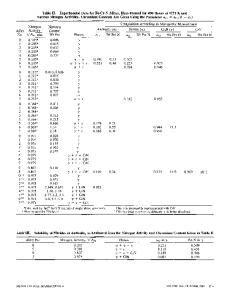Thermodynamic analysis of the In-Ga-Sb system
- PDF / 771,292 Bytes
- 10 Pages / 598 x 778 pts Page_size
- 99 Downloads / 298 Views
I.
INTRODUCTION
As a part of their comprehensive analysis of III-V systems, Panish and Ilegemstl] analyzed the In-Ga-Sb system using a two-parameter, simple solution or quasiregular model for the binary liquid phases. Subsequently, one of the authors t2} showed that an extension to a four-parameter, subregular model was necessary if one wished not only to obtain good fits to the liquidus points and measured thermodynamic properties of the liquid phase, but also to achieve consistency between the thermodynamic properties of the binary liquid phase and those of the III-V compound. This coupling of properties in a III-V binary arises from the congruent melting of the compound and results in the equality of the enthalpy of mixing of the liquid to the sum of the enthalpies of formation and melting of the compounds at the melting point, as well as an analogous equation in the entropy quantities. The subregular model was extended to the ternary system by Kaufman et a l J 3] Experimental enthalpies of mixing for the liquid phase were then determined.t4-T] These were included in an analysis based on an associated solution model for the liquid. [8,9] Most recently, Sharma and co-workers [J~ obtained about equally good fits as in Reference 8 but with an analytically simpler model in which the excess Gibbs energy of mixing is a quartic function of atomic fractions. Here, we use a Margules-type model for the liquid phase, in which the enthalpy and excess entropy of mixing are also quartic functions of the atomic fractions and the enthalpy of mixing is a quadratic function of temperature. We are able to obtain significantly better fits than achieved thus far. Moreover, the calculation is more accurate in that the Gibbs energies of formation of the III-V compounds, required in the liquidus equation, are calculated from the standard enthalpy and entropy of formation at 298 K and heat capacities, rather than being approximated as linear functions of temperature. We also calculate some as yet unmeasured properties such
as the partial pressures of Sb 2 and Sb4 along the three phase curves of the binary compounds and their solid solution and the enthalpy of mixing for temperatures above the range of experimental values.
II. MODELS FOR THE LIQUID AND SOLID SOLUTION PHASES The components In, Ga, and Sb are labeled, respectively, as 1, 2, and 3, and the integral quantities of mixing are assumed to be of the form 2
AT"M = XIX3 Z Wl3m(X3 -- l / 2 ) m + X2X3 m-O 2
9Z W23,,(x3 - 1/2)" + x~x2 W h o m=0
+ XlX2X3(XlV 1 "q- x2V 2 -[- x3V3)
where the interaction coefficients, W0,, and Vj, are functions of temperature and the identity of Z. We note that the 1-2 or In-Ga binary is described as quasiregular. The definition of the model is completed by specifying the interaction coefficients for the enthalpy of mixing, AHM, as WijHm = Aijm q" Bom(T - Tij) Jr Cijm(T - TU) 2
[2]
v " = cj,
[3]
O12 m
=
C12 m -=
0
METALLURGICAL AND MATERIALS TRANSACTIONS A
m = 0, 1, 2
[4]
where T13 and T23 are the melting point of InSb and GaSb, respect
Data Loading...











